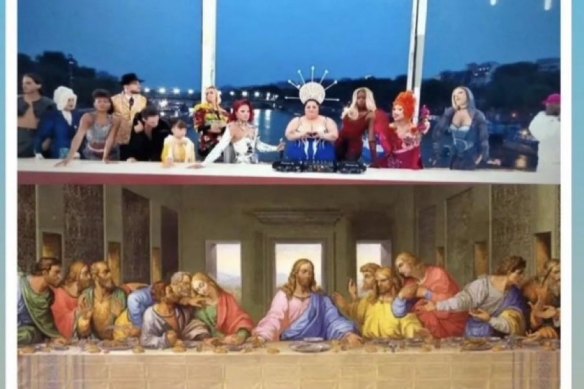‘Not a provocation’: Drag show performers thought biblical painting was inspiration
By Rob Harris
Paris: Two of the artists who participated in the controversial parody sketch at the heart of the Paris Olympics opening ceremony have hinted the performance was intended to imitate Leonardo da Vinci’s famed painting of “The Last Supper”.
Organisers of the Paris Games apologised at the weekend for any offence taken from the bawdy tableau which resembled the biblical scene of Jesus Christ and his 12 apostles sharing a last meal before crucifixion. It was performed by a group of drag queens, a transgender model, a near-naked singer made up as the Greek god of wine Dionysus and set to music by lesbian activist DJ Barbara Butch.

Instagram screenshot shared by Barbara Butch, the lesbian activist who took part in the Paris Olympics opening ceremony. Credit: Instagram
Games organisers said the tableau was an “interpretation of the Greek God Dionysus makes us aware of the absurdity of violence between human beings”, and denied the sequence was inspired by the painting or that it intended to mock or offend.
But Crux, a US-based Catholic news service, reported that French drag queen and rapper known as Piche from the show Drag Race France said the parody was “not a provocation” as it was a “biblical representation that has been reused in pop culture for decades”.
“I received a lot of messages of support and people who were very happy that I was there and very surprised that there were drag queens at the opening ceremony,” he told BFM, adding the opposition to the performance indicated that “we’ve succeeded and we’ve done what had to be done, that we’ve been fair and representative”.
“Art always divides. As long as it doesn’t move people, it’s not art for me. There were no real provocations or anything that was truly obscene,” he said. “We didn’t make fun of the painting at all…it’s really just because it’s queers and drag queens who use that representation that it bothers.”
The controversy went viral online within minutes, attracting the ire of the Catholic Church, some conservative Christian groups and former US President Donald Trump. French bishops were among those criticising the segment and calling it a “mockery of Christianity”.
Barbara Butch, who wore a silver aureole halo crown head-dress and low-cut dress while portraying a figure some interpreted to be Jesus in the sketch, posted a screenshot image of her performance above an image of Da Vinci’s original painting to her Instagram account with the comment, “Oh yes! Oh yes! The new gay testament!” It was later deleted.
Her lawyer, Audrey Msellati, filed a police complaint on Tuesday warning that the DJ would take legal action against anyone seeking to intimidate her online. She has reportedly faced threats of “death, torture and rape as well numerous anti-Semitic, homophobic, sexist and fatphobic insults”.

Instagram screenshot shared by Barbara Butch, the lesbian activist who took part in the Paris Olympics opening ceremony. Credit: Instagram
Ceremony director Thomas Jolly said the idea was “a big pagan party linked to the gods of Olympus” and added that in France “there’s freedom of artistic expression.”
Many believe the scene was based on The Feast of the Gods, painted by the artist Jan van Bijlert between 1635 and 1640.
France, while proud of its rich Catholic heritage, also has a long tradition of secularism and anti-clericalism. Blasphemy is not only legal, but also considered by many as an essential pillar of freedom of speech in a democratic society.
The incident has attracted headlines worldwide, including lengthy analysis in Paris-based Le Monde and The New York Times this week debating whether it was, in fact, parodying the biblical scene or a famous image from Greek mythology.
Sasha Grishin, an art historian and professor emeritus at the Australian National University, told the paper the resemblance to da Vinci’s painting was undeniable.
“The idea of the central figure with a halo and a group of followers on either side — it’s so typical of ‘The Last Supper’ iconography that to read it in any other way might be a little foolhardy,” he said.
But others have argued it was not immediately clear that the scene was referencing The Last Supper because there was at least 17 individuals involved — and more when the blue-painted man, French actor and singer Philippe Katerine, sang.
Louise Marshall, an honorary senior lecturer at the University of Sydney and an expert in Renaissance art said: “That’s basic. You kind of have to have that number.”
On Tuesday, Katerine told French media: “What is certain is that with Thomas Jolly, we never talked about religion, nor about the Last Supper.”
For Olympics news, results and expert analysis sent daily throughout the Games, sign up for our Sport newsletter.